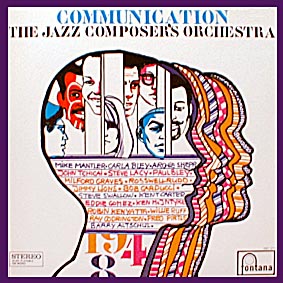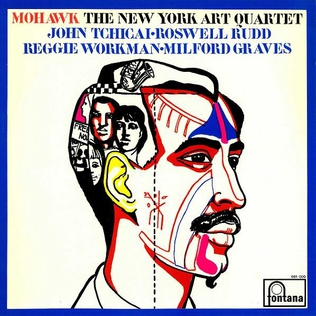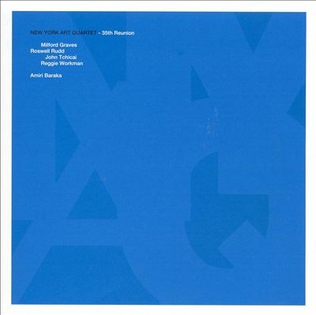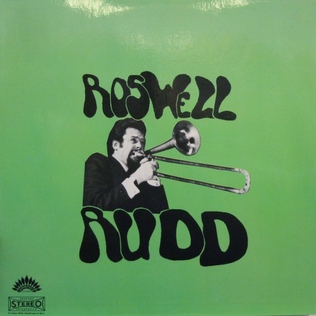Avant-garde jazz is a style of music and improvisation that combines avant-garde art music and composition with jazz. It originated in the early 1950s and developed through to the late 1960s. Originally synonymous with free jazz, much avant-garde jazz was distinct from that style.

Milford Graves was an American jazz drummer, percussionist, Professor Emeritus of Music, researcher/inventor, visual artist/sculptor, gardener/herbalist, and martial artist. Graves was noteworthy for his early avant-garde contributions in the 1960s with Paul Bley, Albert Ayler, and the New York Art Quartet, and is considered to be a free jazz pioneer, liberating percussion from its timekeeping role. The composer and saxophonist John Zorn referred to Graves as "basically a 20th-century shaman."

John Martin Tchicai was a Danish free jazz saxophonist and composer.

Roswell Hopkins Rudd Jr. was an American jazz trombonist and composer.
The New York Art Quartet was a free jazz ensemble, originally made up of saxophonist John Tchicai, trombonist Roswell Rudd, drummer Milford Graves and bassist Lewis Worrell, that came into existence in 1964 in New York City. Worrell was later replaced by various other bassists, including Reggie Workman, Finn Von Eyben, Harold Dodson, Eddie Gómez, Steve Swallow, and Buell Neidlinger. All About Jazz reviewer Clifford Allen wrote that the group "cut some of the most powerful music in the free jazz underground".

Amiri Baraka, previously known as LeRoi Jones and Imamu Amear Baraka, was an American writer of poetry, drama, fiction, essays, and music criticism. He was the author of numerous books of poetry and taught at several universities, including the University at Buffalo and Stony Brook University. He received the PEN/Beyond Margins Award in 2008 for Tales of the Out and the Gone. Baraka's plays, poetry, and essays have been described by scholars as constituting defining texts for African-American culture.

Other Planes of There is an album by the American Jazz musician Sun Ra and his Solar Arkestra. Recorded in 1964, the album had been released by 1966 on Sun Ra's own Saturn label. The record was reissued on compact disc by Evidence in 1992.
'Granted, the selection is certainly not as abrasive and demanding as later efforts, although there is strident involvement from everyone within the dense arrangement. The brass and reed sections provide emphasis behind an off-kilter and loping waltz backdrop. All the more impressive is how well the material has held up over the decades. Even to seasoned ears, the music is pungent and uninhibited, making Other Planes of There a highly recommended collection.' Lindsay Planer
The Cricket, subtitled "Black Music in Evolution", was a magazine created in 1968 by Amiri Baraka, Larry Neal and A. B. Spellman. Baraka has said: "Larry Neal, AB and I realized the historical influence of music on African /Afro American Culture. I saw the magazine as a necessary dispenser of this influence as part of a continuum. And that attention to the culture was a way of drawing attention to the people's needs and struggle." The headquarters was in New York City.

Communication is the debut album by the Jazz Composer's Orchestra featuring compositions by Michael Mantler and Carla Bley performed by Paul Bley, Steve Lacy, Jimmy Lyons, Roswell Rudd, Archie Shepp, John Tchicai, Fred Pirtle, Willie Ruff, Ken McIntyre, Robin Kenyatta, Bob Carducci, Kent Carter, Steve Swallow, Milford Graves, and Barry Altschul. The album was released on the Fontana label in 1965. AllMusic described it as "one of the masterpieces of creative music in the '60s".

The October Revolution in Jazz was a four-day festival of new jazz music which took place at the Cellar Café in New York City. It occurred from October 1–4, 1964, and was organized by composer and trumpeter Bill Dixon. The success of the festival was directly responsible for the formation of the Jazz Composers Guild.

Sonny's Time Now is an album by American free jazz drummer Sunny Murray, his first as a leader. It was recorded in New York City on November 17, 1965 and first released on LeRoi Jones' Jihad label. It was later reissued on the DIW and Skokiaan labels.
Lewis Worrell is a jazz double bassist best known for his work during the 1960s with Albert Ayler, the New York Art Quartet, Roswell Rudd, and Archie Shepp.

The New Wave in Jazz is a live album recorded on March 28, 1965 at the Village Gate in New York City. It features groups led by major avant-garde jazz artists performing at a concert for the benefit of The Black Arts Repertory Theater/School founded by Amiri Baraka, then known as LeRoi Jones. The album was released on LP in 1965 on the Impulse! label, and was reissued on CD in 1994 with a different track listing.

Mohawk is the second album by the New York Art Quartet. It was recorded by Rudy Van Gelder on July 16, 1965, in New York City, and was released later that year by Fontana Records. It features John Tchicai on alto saxophone, Roswell Rudd on trombone, Reggie Workman on bass, and Milford Graves on percussion.

35th Reunion is the third album by the New York Art Quartet. It was recorded at Avatar Studios in New York City on June 14, 1999, and was released in 2000 by DIW Records. It features John Tchicai on alto saxophone, Roswell Rudd on trombone, Reggie Workman on bass, and Milford Graves on percussion. Amiri Baraka, whose poem "Black Dada Nihilismus" was included on the group's debut album, also appears.

Old Stuff is the fourth album by the New York Art Quartet. It was recorded live at the Montmartre Jazzhus and Concert Hall of the Radio House, Danish Broadcasting on October 14 and 24, 1965, and was released in 2010 by Cuneiform Records. It features John Tchicai on alto saxophone, Roswell Rudd on trombone, Finn Von Eyben on bass, and Louis Moholo on drums.

Roswell Rudd is a live album by the trombonist Roswell Rudd, the first recording under his name. It was recorded in November 1965 in Hilversum, Netherlands, and was released by America Records in 1971. On the album, Rudd is joined by saxophonist John Tchicai, bassist Finn Von Eyben, and drummer Louis Moholo.

Call It Art is an album by the New York Art Quartet. It contains previously unissued live and studio tracks recorded in 1964 and 1965, and was released in limited quantities as a five-LP box set by Triple Point Records in 2013. The album includes a 156-page clothbound book containing liner notes by Ben Young, photos, reproductions of manuscripts, and a complete history and itinerary of the group, housed in a custom wooden box. Musicians featured on the album are saxophonist John Tchicai, trombonist Roswell Rudd, bassists Bob Cunningham, Don Moore, Eddie Gómez, Lewis Worrell, and Reggie Workman, and drummers J. C. Moses and Milford Graves. Trumpeter Alan Shorter appears on several tracks, and Amiri Baraka also makes a guest appearance.

The Complete Yale Concert, 1966 is a live album by drummer Milford Graves and pianist Don Pullen. It was recorded in April 1966 at Yale University in New Haven, Connecticut, and was released in 2020 by Corbett vs. Dempsey. The music was initially issued on two LPs: In Concert at Yale University (1966) and Nommo (1967), both released by the musicians on their SRP label.

Four Days in December was a four-day festival of new jazz music that took place at Judson Hall in New York City. Sponsored by the Jazz Composers Guild, it occurred from December 28–31, 1964, and was the group's most visible event. Along with the October Revolution in Jazz, held two months prior and organized by Bill Dixon, it led to a sense of optimism regarding the possibility of producing concerts via non-traditional means.
















